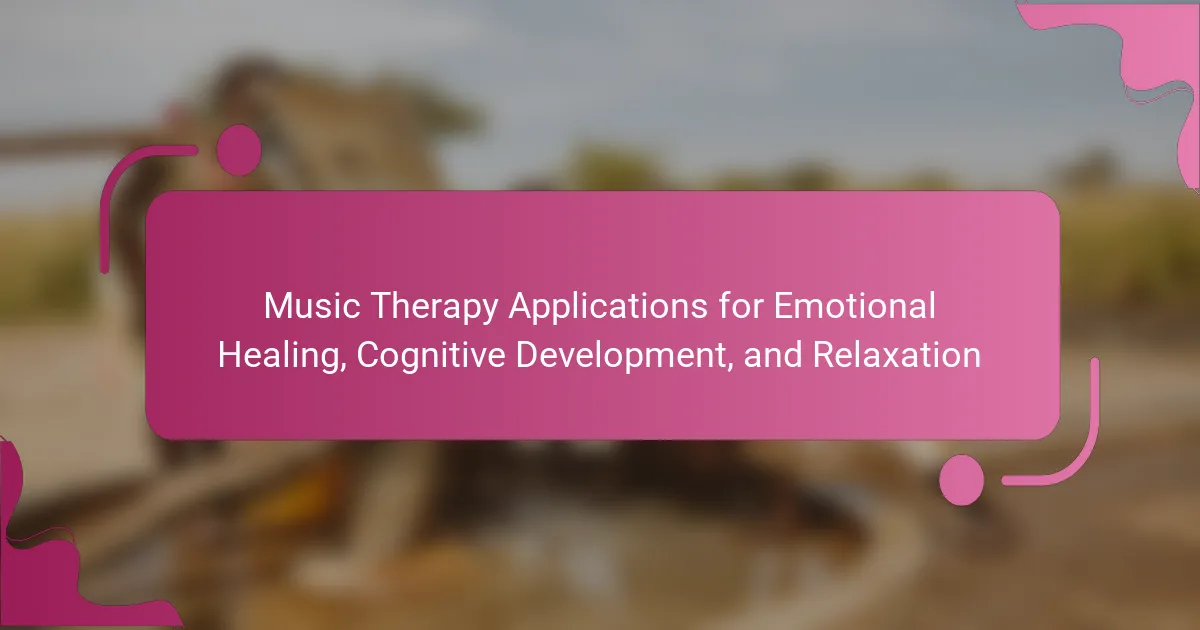Music therapy offers significant benefits for emotional healing, cognitive development, and relaxation. It facilitates emotional expression and resilience while improving memory and attention. This therapeutic approach also promotes stress relief through tailored musical interventions, enhancing overall well-being. Specialized applications in areas like palliative care and autism further demonstrate its versatility in addressing diverse needs.
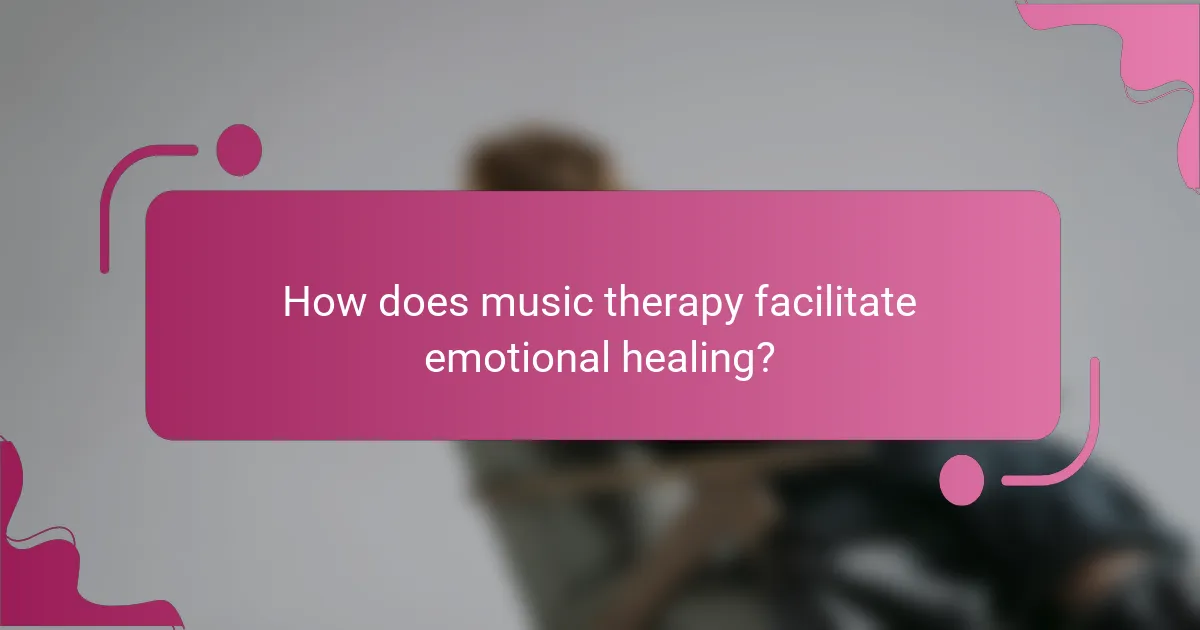
How does music therapy facilitate emotional healing?
Music therapy facilitates emotional healing by using music to express feelings, reduce anxiety, and improve mood. This therapeutic approach engages clients in active music-making, promoting self-awareness and emotional release. Research shows that music therapy can decrease symptoms of depression and PTSD. Additionally, it fosters social connections, enhancing emotional resilience. Through structured sessions, individuals can explore their emotions safely, leading to significant psychological benefits.
What techniques are used in music therapy for emotional healing?
Music therapy employs various techniques for emotional healing, including improvisation, songwriting, and guided imagery. These methods foster emotional expression and self-reflection. For example, improvisation allows individuals to create music spontaneously, promoting emotional release. Songwriting encourages personal storytelling, enhancing self-awareness. Guided imagery paired with music can evoke memories and feelings, facilitating emotional processing. Each technique supports the therapeutic goal of emotional healing through creative expression.
Which populations benefit most from music therapy for emotional healing?
Individuals with autism, dementia, PTSD, and anxiety disorders benefit most from music therapy. Music therapy enhances emotional expression, reduces anxiety, and fosters cognitive engagement. For instance, children with autism show improved social skills through interactive music activities. Elderly patients with dementia experience enhanced mood and memory recall during music sessions. Studies indicate that music therapy significantly lowers stress levels in individuals with PTSD, promoting emotional healing.
What evidence supports the effectiveness of music therapy in emotional healing?
Music therapy is effective in emotional healing, supported by numerous studies. Research shows it reduces anxiety, depression, and stress while enhancing emotional expression. A meta-analysis indicated that music therapy significantly improves emotional well-being in various populations, including children and adults. Additionally, case studies reveal that patients with trauma and PTSD often experience relief through tailored music interventions. These findings highlight music therapy’s unique ability to foster emotional resilience and facilitate healing processes.
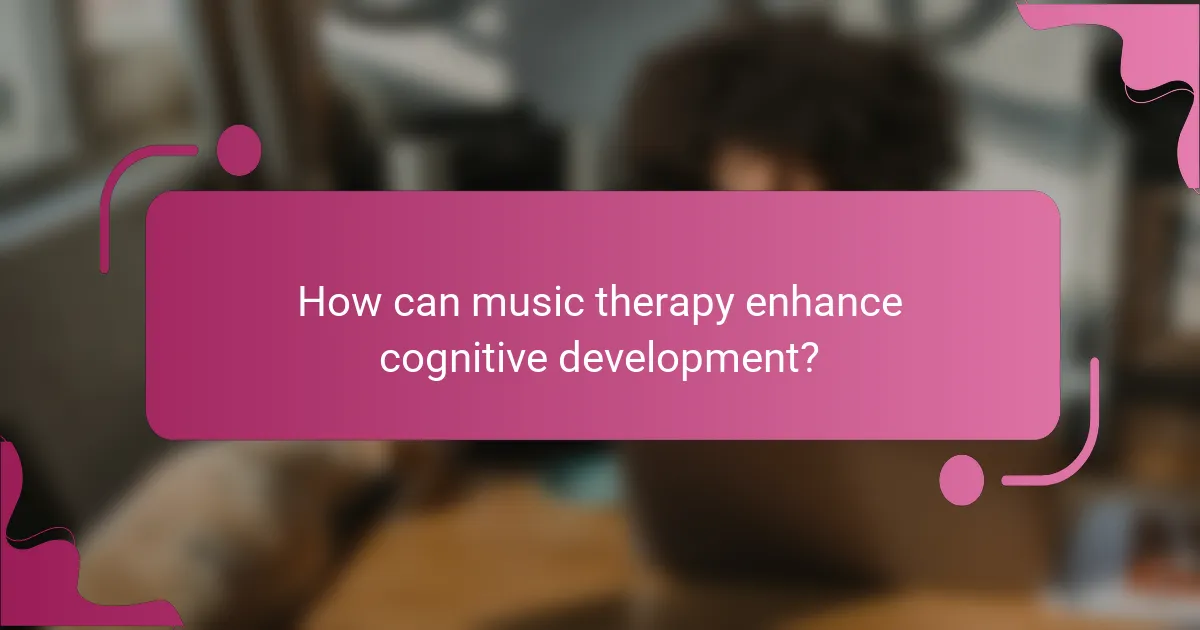
How can music therapy enhance cognitive development?
Music therapy enhances cognitive development by improving memory, attention, and problem-solving skills. It engages multiple brain areas, fostering neural connections. Research shows that children exposed to music therapy exhibit higher cognitive performance compared to peers without such exposure. Additionally, music therapy can reduce anxiety, allowing for better focus and learning. This holistic approach supports emotional healing while simultaneously promoting cognitive growth.
What specific cognitive skills can be improved through music therapy?
Music therapy can significantly enhance various cognitive skills, including memory, attention, and problem-solving. Engaging with music stimulates brain areas responsible for these functions. Research indicates that music therapy improves verbal memory and executive functions in individuals with cognitive impairments. Additionally, it fosters social skills and emotional regulation, contributing to overall cognitive development.
How does music therapy influence learning in children and adults?
Music therapy significantly enhances learning in children and adults by improving emotional regulation, cognitive skills, and relaxation. It fosters creativity and engagement, which are crucial for effective learning. For example, children exposed to music therapy show increased attention spans and better memory retention. Adults benefit from reduced anxiety and enhanced problem-solving abilities, facilitating a more conducive learning environment. The unique ability of music therapy to connect emotionally with learners makes it a powerful tool for educational settings.
Which age groups show the most significant cognitive benefits from music therapy?
Children and older adults show the most significant cognitive benefits from music therapy. Research indicates that children, particularly those with developmental disorders, experience enhanced language skills and memory. Older adults, especially those with dementia, benefit from improved cognitive function and emotional well-being. Music therapy promotes neural connections, aiding cognitive development across these age groups.
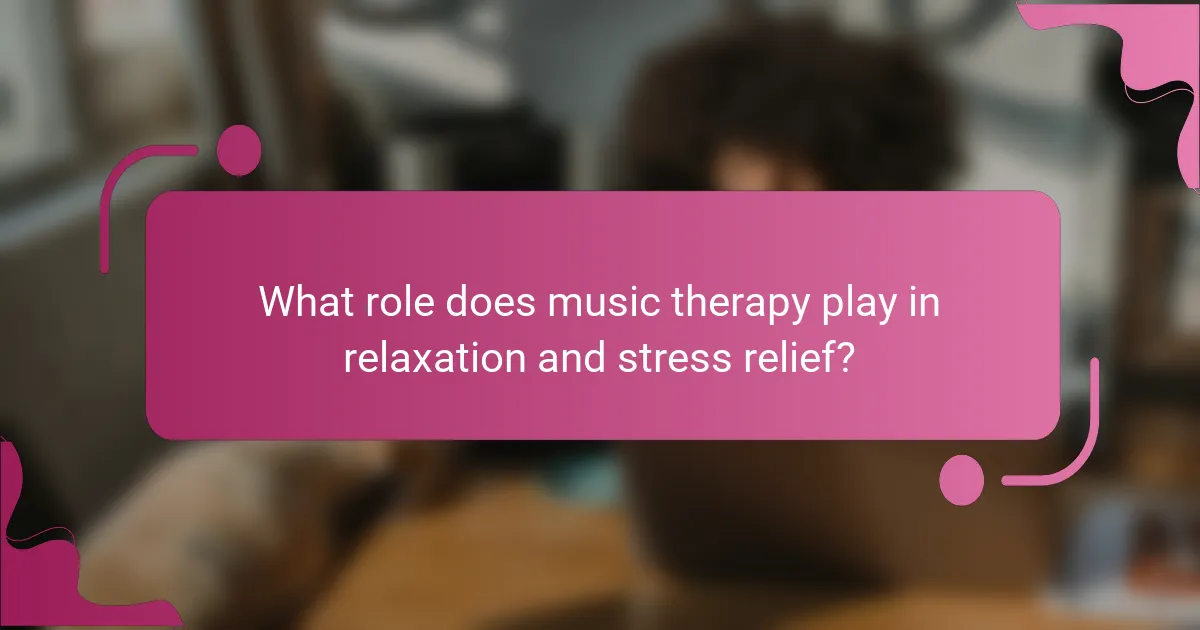
What role does music therapy play in relaxation and stress relief?
Music therapy significantly aids relaxation and stress relief by using sound to promote emotional healing. It engages individuals in active listening and creative expression, lowering anxiety levels. Research shows that music therapy can decrease cortisol, a stress hormone, enhancing overall well-being. Additionally, it fosters emotional connections, allowing individuals to process feelings and experiences, which contributes to stress relief. By incorporating various musical elements, therapists tailor sessions to meet unique client needs, making it a versatile approach for managing stress.
How does music therapy reduce anxiety and promote relaxation?
Music therapy effectively reduces anxiety and promotes relaxation through structured musical interventions. Research shows that music therapy lowers cortisol levels, which are linked to stress. It enhances emotional expression, allowing individuals to process feelings in a safe environment.
Additionally, music therapy can improve mood by stimulating the release of dopamine, a neurotransmitter associated with pleasure. This therapeutic approach often incorporates techniques such as guided imagery with music and active music-making, fostering a sense of control and empowerment in participants.
The unique attribute of music therapy lies in its adaptability; it can be tailored to individual preferences and needs, making it a personalized experience. As a result, clients often report significant reductions in anxiety levels and improved relaxation after sessions.
What types of music are most effective for relaxation in therapy sessions?
Ambient music, classical music, and nature sounds are most effective for relaxation in therapy sessions. These genres promote calmness and reduce anxiety. Ambient music creates a soothing atmosphere, while classical music has been shown to lower heart rates and enhance emotional well-being. Nature sounds, such as ocean waves or rain, can evoke feelings of tranquility and connection to the environment. Each type supports emotional healing and cognitive development by fostering a peaceful therapeutic space.
Which settings are ideal for implementing music therapy for relaxation?
Ideal settings for implementing music therapy for relaxation include quiet rooms, nature settings, and therapeutic spaces. These environments reduce distractions and enhance the soothing effects of music. For example, a calm room with comfortable seating promotes a sense of safety and openness. Nature settings, such as gardens, leverage natural sounds to complement music, fostering deeper relaxation. Therapeutic spaces designed specifically for music therapy often include soundproofing and acoustic enhancements to optimize the experience.
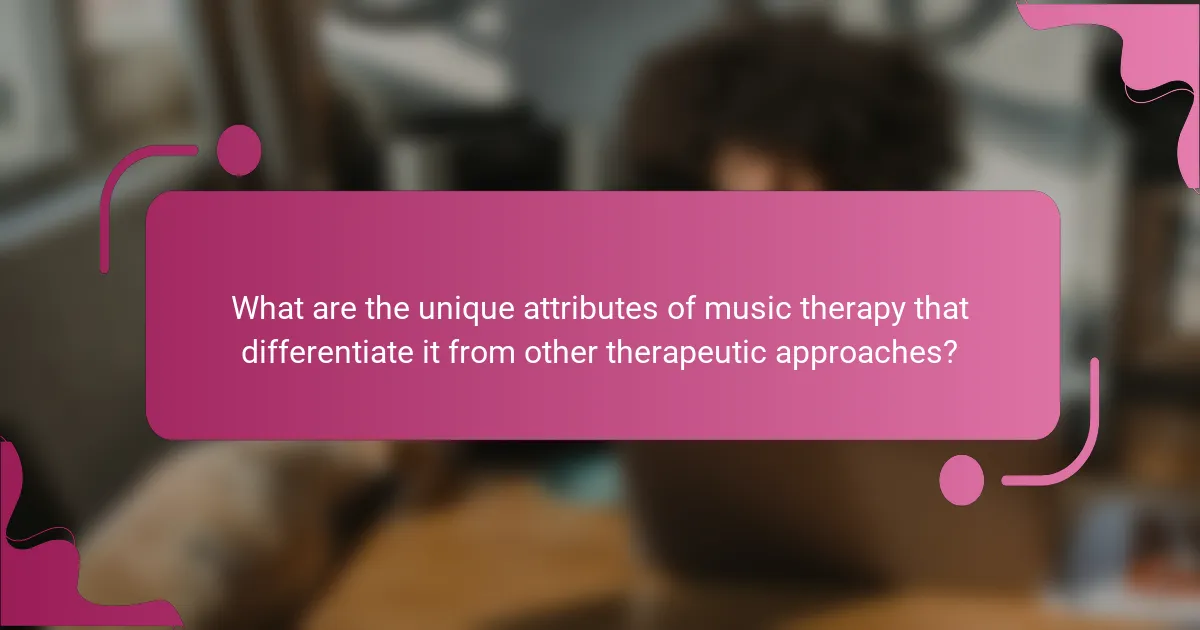
What are the unique attributes of music therapy that differentiate it from other therapeutic approaches?
Music therapy uniquely combines musical elements with therapeutic practices to enhance emotional healing, cognitive development, and relaxation. Its interactive nature fosters personal expression, creating a safe space for individuals to process emotions.
One unique attribute is its ability to engage non-verbal communication, facilitating connections for those who struggle with traditional verbal therapies. Music therapy also employs rhythmic and melodic structures, which can stimulate brain activity and promote cognitive skills.
Additionally, the tailored interventions in music therapy can adapt to individual preferences, enhancing motivation and engagement compared to other therapeutic approaches. This personalized approach can lead to significant emotional breakthroughs and cognitive improvements.
Overall, the integration of music as a therapeutic tool distinguishes music therapy from conventional therapies, providing a holistic avenue for healing and development.
How does the personalization of music therapy enhance its effectiveness?
Personalization of music therapy enhances its effectiveness by tailoring interventions to individual needs. Customized approaches address specific emotional challenges, cognitive goals, and relaxation preferences. This individualized focus fosters deeper engagement and promotes better outcomes. Research indicates personalized music therapy can lead to significant improvements in emotional well-being and cognitive function, as it resonates with the unique experiences of each participant. By aligning therapeutic techniques with personal preferences, music therapy becomes more impactful, ultimately facilitating a stronger therapeutic alliance and promoting sustained progress.
What cultural influences shape the practice of music therapy?
Cultural influences such as traditions, beliefs, and community practices shape music therapy. These elements affect how music is perceived and utilized in emotional healing, cognitive development, and relaxation across different societies. For example, indigenous cultures often incorporate traditional songs to foster healing and community bonding. In contrast, Western practices may emphasize structured techniques and scientific validation. Understanding these influences enhances the effectiveness of music therapy by aligning it with cultural values and expectations.
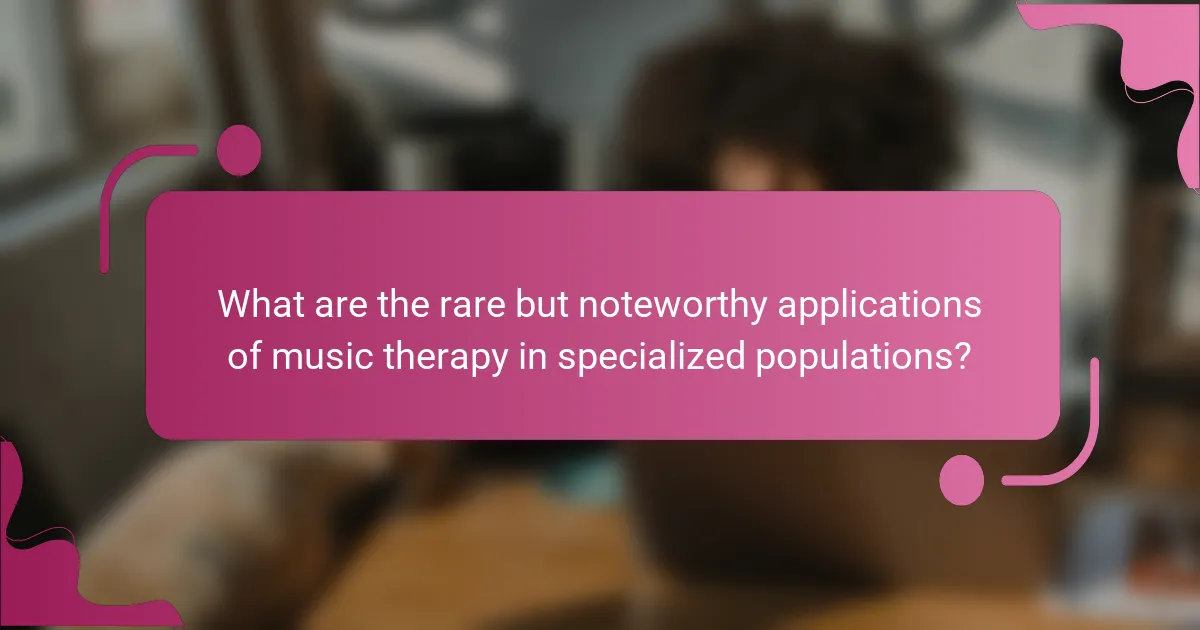
What are the rare but noteworthy applications of music therapy in specialized populations?
Music therapy has rare but impactful applications in specialized populations, enhancing emotional healing, cognitive development, and relaxation. One notable application is in palliative care, where music therapy alleviates pain and anxiety in terminally ill patients. In individuals with autism, music therapy fosters social skills and communication. Another unique use is in dementia care, where familiar music triggers memories and improves mood. Additionally, music therapy aids in trauma recovery for veterans, providing a safe space to process emotions. These applications highlight music therapy’s versatility in addressing diverse needs.
How is music therapy utilized in palliative care?
Music therapy is utilized in palliative care to enhance emotional healing, cognitive development, and relaxation. This therapeutic approach provides patients with a means to express feelings, reduce anxiety, and improve overall well-being.
Music therapy sessions often involve personalized playlists, live music performances, or guided improvisation. These activities foster emotional connections and facilitate communication, especially for patients with limited verbal abilities.
Research indicates that music therapy can lead to significant improvements in mood and pain management. For instance, studies show that patients experience a 30% reduction in anxiety levels after music therapy sessions.
Additionally, music therapy promotes cognitive engagement through memory recall and sensory stimulation. This aspect is particularly beneficial for patients with cognitive decline, as it can enhance their quality of life and provide moments of joy.
What innovative practices are emerging in music therapy for neurological disorders?
Innovative practices in music therapy for neurological disorders include personalized music interventions, technology integration, and multi-sensory approaches. These methods enhance emotional healing, cognitive development, and relaxation.
Personalized music interventions tailor sessions to individual preferences, improving engagement and outcomes. Technology integration, such as virtual reality and mobile applications, allows for immersive experiences that can stimulate cognitive functions. Multi-sensory approaches combine music with visual and tactile elements to create holistic therapeutic environments.
Research shows that these practices lead to significant improvements in mood, memory, and overall quality of life for patients with neurological disorders. For example, studies indicate that music therapy can reduce anxiety and enhance communication skills in individuals with conditions like Alzheimer’s and Parkinson’s disease.
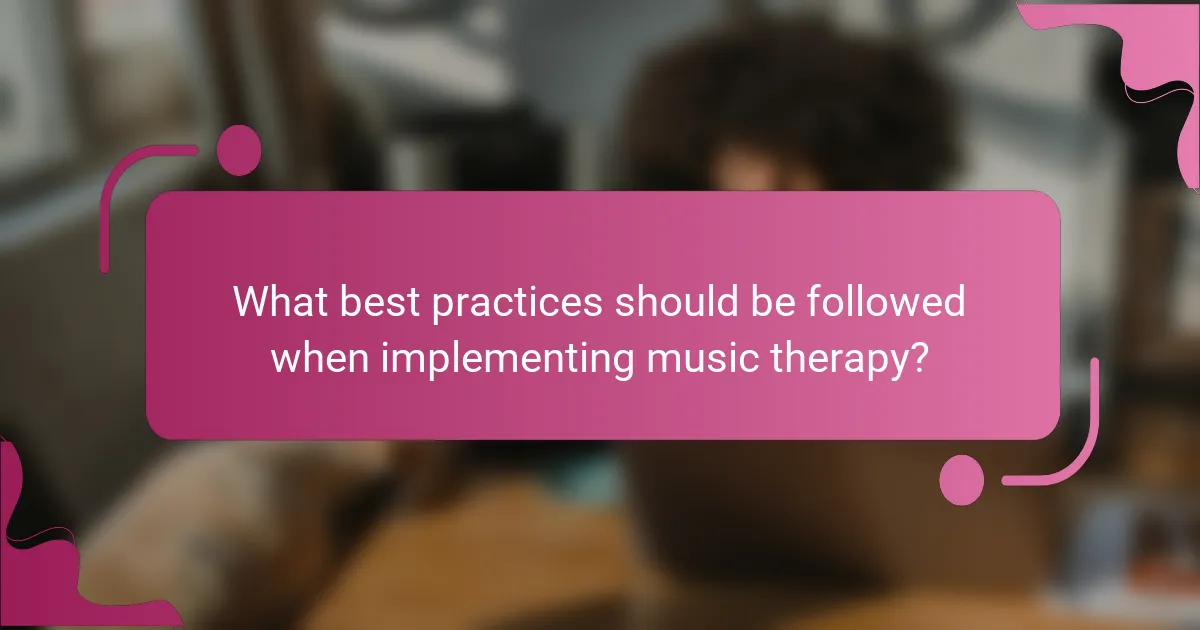
What best practices should be followed when implementing music therapy?
Implementing music therapy effectively requires following best practices that enhance emotional healing, cognitive development, and relaxation. Prioritize individualized assessments to tailor sessions to specific needs. Incorporate diverse musical genres to engage clients and foster connection. Establish a safe, supportive environment to encourage expression and participation. Regularly evaluate progress and adapt techniques to ensure optimal outcomes. Collaborate with other professionals for a holistic approach to client care.
How can practitioners measure the success of music therapy interventions?
Practitioners can measure the success of music therapy interventions through various assessment tools and client feedback. Standardized scales, such as the Music Therapy Assessment Tool, provide quantitative data on emotional and cognitive improvements. Additionally, qualitative feedback from clients can reveal personal experiences and perceived benefits. Regular progress evaluations ensure therapy aligns with individual goals. Tracking changes in mood, social interaction, and cognitive function offers a comprehensive view of effectiveness.
What common mistakes should be avoided in music therapy practices?
Common mistakes to avoid in music therapy practices include lack of individualized treatment plans, inadequate training for therapists, neglecting client feedback, and failing to measure progress. These errors can hinder emotional healing and cognitive development.
Individualized treatment plans are crucial; a one-size-fits-all approach often ignores unique client needs. Inadequate training can lead to ineffective techniques that fail to address specific issues. Client feedback is essential for adapting sessions to enhance effectiveness. Lastly, measuring progress is vital for evaluating the success of interventions and making necessary adjustments.
Which resources are recommended for further learning about music therapy?
Recommended resources for further learning about music therapy include books, online courses, and professional organizations. Notable books include “The Healing Power of Music” and “Music Therapy: A Clinical Introduction.” Online platforms like Coursera and Udemy offer courses on music therapy techniques. The American Music Therapy Association provides valuable resources and networking opportunities for practitioners. Additionally, attending workshops and conferences can enhance understanding of music therapy applications in emotional healing, cognitive development, and relaxation.
